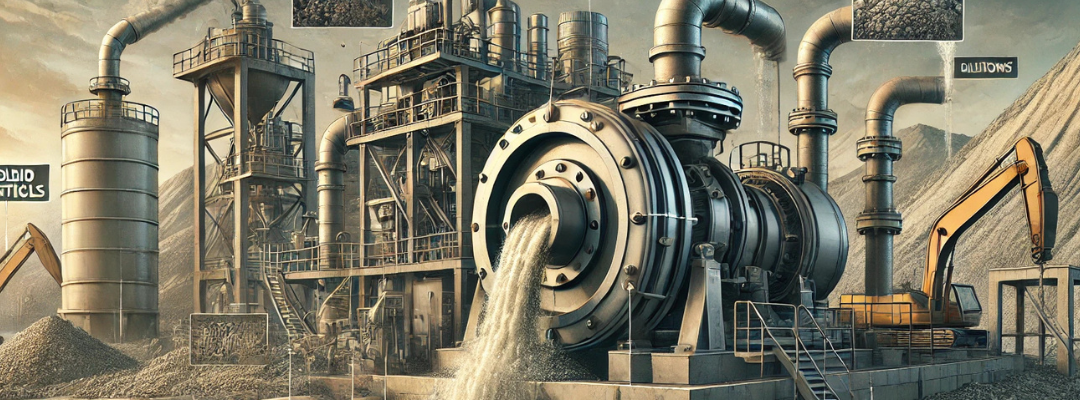Pumping slurries—mixtures of water and solid particles—is a complex and demanding task in the mining and mineral processing industry. Slurries are often highly abrasive, dense, and chemically aggressive, causing significant wear and operational inefficiencies. Selecting the right pump type, materials, and system design is crucial to minimizing downtime, reducing maintenance costs, and optimizing energy efficiency.
This article explores the key challenges in slurry pumping and presents advanced solutions that improve system reliability and longevity.
Major Challenges in Slurry Pumping and Effective Solutions
1. Extreme Abrasion and Wear
- Challenge: Solid particles such as crushed ore, sand, or coal lead to rapid wear of pump components, including impellers, casings, and liners.
Advanced Solution:
- Wear-Resistant Materials: Utilize chrome-alloy, tungsten carbide, polyurethane, or ceramic coatings to extend component lifespan.
- Thick-Walled Casings: Designed to withstand high-velocity impact, reducing replacement frequency.
- Optimized Impeller Design: Semi-open or vortex impellers minimize direct contact with solids, reducing erosion rates.
2. Handling High Solids Concentration
- Challenge: Some slurries contain up to 70% solids by weight, increasing viscosity and making pumping difficult.
Advanced Solution:
- Heavy-Duty Centrifugal Pumps: Designed with larger, open passages to prevent clogging.
- Peristaltic and Piston Diaphragm Pumps: Maintain consistent flow with minimal clogging, ideal for extremely dense slurries.
- Pump Sizing Optimization: Proper selection prevents underperformance and excessive energy use.
3. Cavitation and Pump Damage
- Challenge: Pressure variations cause vapor bubbles that implode, damaging impellers and reducing efficiency.
Advanced Solution:
- Optimized Net Positive Suction Head (NPSH): Designing suction lines with minimal pressure drop prevents cavitation.
- Axial Flow and Vortex Impellers: Reduce turbulence and minimize pressure fluctuations.
4. Corrosion Resistance in Harsh Environments
- Challenge: Chemical exposure in applications like gold, copper, and nickel mining accelerates material degradation.
Advanced Solution:
- Corrosion-Resistant Materials: Duplex stainless steel, hastelloy, or non-metallic thermoplastics.
- Protective Coatings: Rubber linings or epoxy-based coatings shield internal components from chemical attack.
5. Large Solids and Particle Size Variation
Challenge: Slurries often contain large or fibrous solids that can clog or damage impellers.
Advanced Solution:
- Vortex Pumps: Create a whirlpool effect to suspend solids without direct contact with impellers.
- Chopper Pumps: Break down oversized solids before they enter the main pumping chamber.
6. High-Pressure and Long-Distance Transport
Challenge: Mining operations require transporting slurries over long distances or steep inclines, demanding high-pressure pumping.
Advanced Solution:
- Multistage Centrifugal Pumps: Achieve high pressures for long-distance transport.
- Booster Stations: Installed along the pipeline to maintain flow efficiency.
- Positive Displacement Pumps: Handle high-viscosity slurries at constant pressure with minimal pulsation.
7. Energy Efficiency and System Optimization
Challenge: Slurry pumping is energy-intensive, leading to high operating costs.
Advanced Solution:
- Variable Frequency Drives (VFDs): Adjust pump speed based on demand, reducing energy waste.
- Real-Time Monitoring Systems: IoT-based sensors detect wear patterns, enabling predictive maintenance.
- Optimized Hydraulic Design: Reduces turbulence, improving efficiency and longevity.
Best Pump Types for Slurry Applications
1. Centrifugal Slurry Pumps
- Best For: High-flow applications with small to medium particles.
- Advantages: Cost-effective, multiple configurations available.
- Limitations: Prone to wear in highly abrasive environments.
2. Peristaltic Pumps
- Best For: Highly viscous or abrasive slurries.
- Advantages: Minimal internal wear, self-priming capability.
- Limitations: Limited to lower flow rates.
3. Diaphragm Pumps
- Best For: High-pressure, high-solids-content applications.
- Advantages: Positive displacement action ensures constant flow rate.
- Limitations: More complex maintenance compared to centrifugal pumps.
4. Vortex Pumps
- Best For: Handling large or irregular solids.
- Advantages: Reduced impeller wear, longer lifespan.
- Limitations: Lower efficiency for fine-particle slurries.
Innovations in Slurry Pumping Technology
- Smart Pumps with AI Monitoring: Automated diagnostics detect inefficiencies before failure occurs.
- 3D-Printed Wear Components: Reduce cost and allow rapid replacement of damaged parts.
- Hybrid Pumping Systems: Combining centrifugal and positive displacement technology for enhanced performance.

